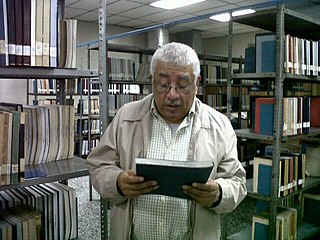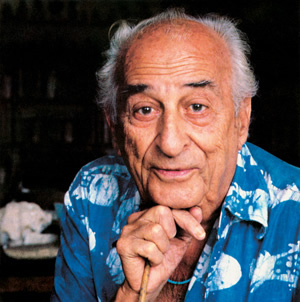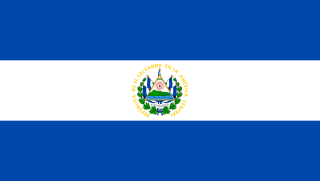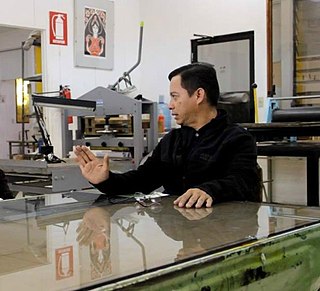
José Francisco Morazán Quesada was a Central American politician who was president of the Federal Republic of Central America from 1830 to 1839. Before he was president of Central America he was the head of state of Honduras. He rose to prominence at the Battle of La Trinidad on November 11, 1827. Morazán then dominated the political and military scene of Central America until his execution in 1842.

The El Salvador national football team represents El Salvador in international football, and is governed by the Salvadoran Football Federation (FESFUT).

Carlos Basilio Ezeta y León was President of El Salvador from 22 June 1890 to 9 June 1894, when he was overthrown in the Revolution of the 44. He was a military ruler. He died on 21 March 1903, aged 50.

Manlio Argueta is a Salvadoran writer, critic, and novelist. Although he is primarily a poet, he is best known in the English speaking world for his novel One Day of Life.

Luis Nishizawa was a Mexican artist known for his landscape work and murals, which often show Japanese and Mexican influence. He began formal training as an artist in 1942 at the height of the Mexican muralism movement but studied other painting styles as well as Japanese art. In addition to painting canvases and murals, including murals made with ceramics, he was a professor of fine arts at the Universidad Nacional Autónoma de México from which he received an honorary doctorate. The State of Mexico, where he was born, created the Museo Taller Luis Nishizawa to honor and promote his life’s work.

Héctor Julio Páride Bernabó or Carybé was an Argentine-Brazilian painter, engraver, draughtsman, illustrator, potter, sculptor, mural painter, researcher, historian and journalist. He settled in Brazil and naturalized as a Brazilian.

Carlos Salazar Castro was a Central American military officer and Liberal politician. Briefly in 1834 he was provisional president of El Salvador, and in 1839 he was provisional president of Guatemala.

Antonio José Cañas Quintanilla was a Salvadoran military officer, diplomat, and politician. For two brief periods he was head of state of the State of El Salvador, within the Federal Republic of Central America.

Salvadorans, also known as Salvadorians, are citizens of El Salvador, a country in Central America. Most Salvadorans live in El Salvador, although there is also a significant Salvadoran diaspora, particularly in the United States, with smaller communities in other countries around the world.

Vicente Alberto Masferrer Mónico, known as Alberto Masferrer, was a Salvadoran essayist, philosopher, fiction writer, and journalist, best known for the development of the philosophy of 'vitalismo'. He was born in Alegría, Usulután formerly Tecape, Usulután on 24 July 1868. He did not receive a formal education, instead claiming to have been educated by "the university of life," but he did travel widely, having lived in several Central American countries, as well as in Chile, New York, and several European nations. During his public career at the Ministry of Foreign Affairs of El Salvador, he served as an ambassador of El Salvador in Argentina, Chile, Costa Rica, and Belgium, and served as a professor in Guatemala, El Salvador, Honduras, Costa Rica, Chile, and Argentina. Having served in the government of President Arturo Araujo, he was sent into exile in Honduras by the dictatorship of Maximiliano Hernández Martínez following the uprising of 1932 known as the 1932 Salvadoran peasant massacre, dying that same year on 8 September in the city of Tegucigalpa.. He was well respected during his life, having earned the praise of such major Salvadoran figures as Arturo Ambrogi, Miguel Ángel Espino, Claudia Lars, and Salarrué.
Salvadoran Australians are Australians of Salvadoran descent. Salvadoran immigration to Australia was caused principally by economic and political turmoil in El Salvador.
Rafael Menjívar Larín was a Salvadoran economist and politician. An outspoken left-wing critical of the Somoza dictatorship, he was director of the University of El Salvador before being thrown into jail and forced abroad into exile.

This is an Index of Central America-related articles. This index defines Central America as the seven nations of Belize, Costa Rica, El Salvador, Guatemala, Honduras, Nicaragua, and Panama.

Giovanni Gil, also known as Hector Giovanni Gil Portillo is a plastic artist and one of the greatest exhibitors of Engraving in El Salvador. He is the founder and director of the projects Soñar al Revés [Dreaming Backwards] and Bajo Presión [Under Pressure] and is the winner of the Silver Medal at the Salon of Contemporary Art El Salvador-

Canada–El Salvador relations refers to the diplomatic relations between the Canada and the Republic of El Salvador. Both nations are members of the Organization of American States and the United Nations.

Tomás Povedano de Arcos was a Spanish painter, who spent much of his life in Costa Rica.
The War of 1907 was a conflict fought between El Salvador and an alliance between Honduras, Nicaragua, Salvadoran exiles, and American filibusters. The invasion of El Salvador on 11 June 1907 resulted in a quick military victory for El Salvador as invading forces withdrew by the end of the day. The war officially ended with the signing of a peace treaty on 20 December 1907 which established the Central American Court of Justice.

Christian Alonso Martínez Mena is a professional footballer who plays as a midfielder for San Carlos. Born in Costa Rica and of Salvadoran descent, Martínez represented the Costa Rica national team in two friendlies, before switching to represent the El Salvador national team.
The El Salvador–Honduras football rivalry is a sports rivalry between the El Salvador and Honduras national football teams. The rivalry between the two nations peaked in 1969 when both teams played each other in the 1970 FIFA World Cup qualifiers, and the matches they played between each other, which ultimately saw El Salvador advance to the 1970 FIFA World Cup, were a contributing factor which led to the outbreak of the Football War in July 1969.

From January 1822 to July 1823, the five Central American nations of Costa Rica, El Salvador, Guatemala, Honduras, and Nicaragua were under the control of the First Mexican Empire, and briefly, the Supreme Executive Power. Each nation was one of the five southernmost provinces of the Mexican Empire, and their incorporation brought Mexico to the height of its territorial extent.